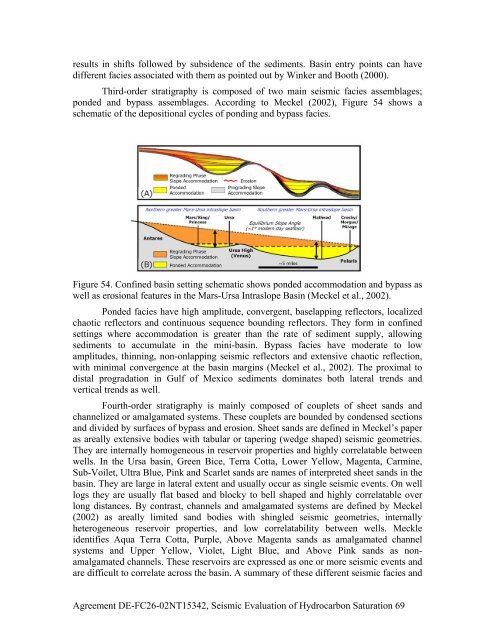Agreement DE-FC26-02NT15342, Seismic Evaluation of ...
Agreement DE-FC26-02NT15342, Seismic Evaluation of ...
Agreement DE-FC26-02NT15342, Seismic Evaluation of ...
You also want an ePaper? Increase the reach of your titles
YUMPU automatically turns print PDFs into web optimized ePapers that Google loves.
esults in shifts followed by subsidence <strong>of</strong> the sediments. Basin entry points can have<br />
different facies associated with them as pointed out by Winker and Booth (2000).<br />
Third-order stratigraphy is composed <strong>of</strong> two main seismic facies assemblages;<br />
ponded and bypass assemblages. According to Meckel (2002), Figure 54 shows a<br />
schematic <strong>of</strong> the depositional cycles <strong>of</strong> ponding and bypass facies.<br />
Figure 54. Confined basin setting schematic shows ponded accommodation and bypass as<br />
well as erosional features in the Mars-Ursa Intraslope Basin (Meckel et al., 2002).<br />
Ponded facies have high amplitude, convergent, baselapping reflectors, localized<br />
chaotic reflectors and continuous sequence bounding reflectors. They form in confined<br />
settings where accommodation is greater than the rate <strong>of</strong> sediment supply, allowing<br />
sediments to accumulate in the mini-basin. Bypass facies have moderate to low<br />
amplitudes, thinning, non-onlapping seismic reflectors and extensive chaotic reflection,<br />
with minimal convergence at the basin margins (Meckel et al., 2002). The proximal to<br />
distal progradation in Gulf <strong>of</strong> Mexico sediments dominates both lateral trends and<br />
vertical trends as well.<br />
Fourth-order stratigraphy is mainly composed <strong>of</strong> couplets <strong>of</strong> sheet sands and<br />
channelized or amalgamated systems. These couplets are bounded by condensed sections<br />
and divided by surfaces <strong>of</strong> bypass and erosion. Sheet sands are defined in Meckel’s paper<br />
as areally extensive bodies with tabular or tapering (wedge shaped) seismic geometries.<br />
They are internally homogeneous in reservoir properties and highly correlatable between<br />
wells. In the Ursa basin, Green Bice, Terra Cotta, Lower Yellow, Magenta, Carmine,<br />
Sub-Voilet, Ultra Blue, Pink and Scarlet sands are names <strong>of</strong> interpreted sheet sands in the<br />
basin. They are large in lateral extent and usually occur as single seismic events. On well<br />
logs they are usually flat based and blocky to bell shaped and highly correlatable over<br />
long distances. By contrast, channels and amalgamated systems are defined by Meckel<br />
(2002) as areally limited sand bodies with shingled seismic geometries, internally<br />
heterogeneous reservoir properties, and low correlatability between wells. Meckle<br />
identifies Aqua Terra Cotta, Purple, Above Magenta sands as amalgamated channel<br />
systems and Upper Yellow, Violet, Light Blue, and Above Pink sands as nonamalgamated<br />
channels. These reservoirs are expressed as one or more seismic events and<br />
are difficult to correlate across the basin. A summary <strong>of</strong> these different seismic facies and<br />
<strong>Agreement</strong> <strong>DE</strong>-<strong>FC26</strong>-<strong>02NT15342</strong>, <strong>Seismic</strong> <strong>Evaluation</strong> <strong>of</strong> Hydrocarbon Saturation 69
















